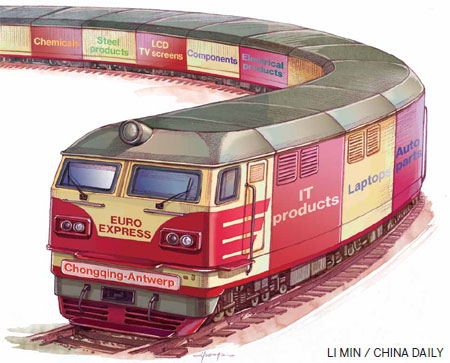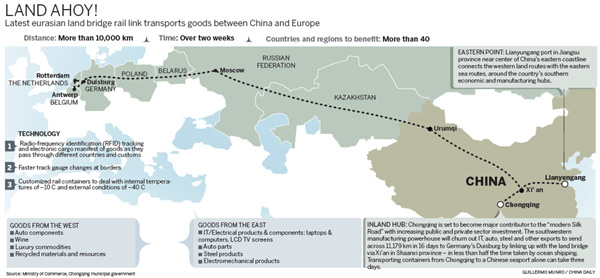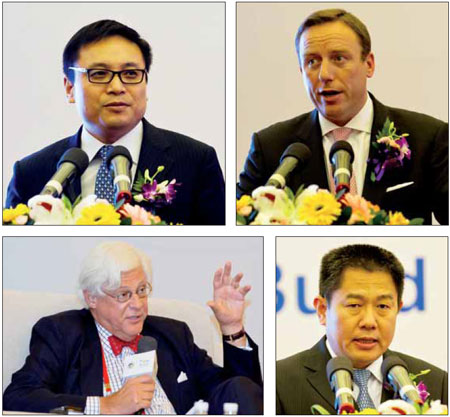On track
Updated: 2012-06-08 09:27
By Alexis Hooi and Ma Wei (China Daily)
|
||||||||

Inter-continental railway promises to be 'New Silk Road' by Bridging businesses of East, West
| ||||
The historic route declined in the centuries that followed as maritime trade increased, but there are now renewed efforts to revive the continental link - this time through the latest addition to the Eurasian Land Bridge rail.
Connecting the major Lianyungang port in East China's Jiangsu province to distant Belgium, the railway is being promoted as a shorter, more efficient way to transport goods between China and Europe. Lianyungang lies near the center of China's eastern coastline, where the country's southern economic and manufacturing hubs have helped enrich cities in provinces like Jiangsu and Zhejiang.
The land bridge traverses more than 10,000 km through China, Central Asia and Eastern Europe before arriving at European trading hubs like Rotterdam and Antwerp in about two weeks. The route is expected to benefit more than 40 countries and regions by taking less than half the time and enjoying a similar reduction in costs compared with transporting goods by sea.
Other routes under the Eurasian Land Bridge concept include an earlier one that consists of the Trans-Siberian Railway and the Russian seaport of Vladivostok. Yet another rail link considers connecting the southern Chinese city of Shenzhen with Rotterdam, through a 15,000-km route across 17 countries and regions - via Guangdong and Yunnan provinces as well as the Guangxi Zhuang autonomous region in China - before entering Myanmar, Bangladesh, India, Pakistan, Iran and Turkey toward its western destination.
Faced with higher production costs, maturing manufacturing industries and changing economic modes in eastern China's more economically developed coastal areas, Chinese authorities are now stepping up efforts to promote the benefits of the latest working route of the land bridge for Chinese goods to reach markets in the West as they look for ways to stay competitive.
Shen Dingli, professor of international studies at Shanghai-based Fudan University and executive dean of its Institute of International Studies, says the land bridge can help break the logistical barriers and bottlenecks in China's regional logistics flow as the country's western regions stand to benefit significantly from the new link.
To that effect, Chongqing, the southwestern municipality and an increasingly important manufacturing and trading hub of inland China, is already positioning itself as the latest crucial link of this Eurasian land bridge.
The megacity, one of the largest and fastest growing cities in the world with a 32-million-strong population, has opened a route to form part of the land bridge in the north at Shaanxi's provincial capital Xi'an - the historic city that flourished as the Chinese terminus of the Silk Road centuries ago.
The new link is expected to offer an attractive alternative for trading companies in Chongqing that need to operate through southern Chinese coastal ports such as Shanghai or Guangzhou before shipping their goods through the Strait of Malacca if they choose the maritime route, which can end up being more time consuming and costly.
Logistics companies such as DB Schenker and Far East Land Bridge are already using the land route to transport containers between Chongqing and European ports like Duisburg in Germany's Ruhr industrial belt.
The Chongqing-Europe link, which takes about two weeks, is banking on the megacity's Chinese goods coming from the IT, electronics, auto, steel, chemical and other sectors that are headed for European markets. Chongqing authorities say the railway will also seal the city as an international logistics hub by connecting the Yangtze River Delta economic belt to Europe.
Xu Ming, a senior official of Chongqing municipal committee, says the land bridge will be vital to China-Europe businesses.
"The old Silk Road connected the Eastern and Western empires. It was a great trading route of utmost importance and a vital artery in international commerce and the exchange of ideas between East and West.
"This new route linking Chongqing to the West is the next big thing. It can shorten present shipping times by up to 20 days. It has received full support from various government ministries and departments to ensure smooth flow and handling of goods. In terms of safety and security, it trumps the threats that maritime shipping might face, such as piracy," Xu said at this year's Liangjiang Forum in Chongqing to discuss the development of the land bridge as part of the challenges and opportunities in western China with business leaders and officials from both sides. Xu is also the director general of the administrative committee of Chongqing's new Liangjiang development area.
"This 'New Silk Road' is better, faster and more efficient as it transports valuable goods between China and Europe. China-EU trade last year hit nearly $600 billion. Europe is China's biggest export market and we are Europe's second largest. In terms of luxury goods, China is set to become the largest market and that also has great significance for the European luxury goods market," he says.
"Chongqing is a major manufacturing hub and draws on the strengths of the Yangtze River Delta as an economic center. Its transportation links connect important cities and regions.
"As the next major trading link between China and Europe, the economic significance of its impact on helping the European debt crisis cannot be underestimated."
Zhai Qian, deputy director general of the European Department at the Ministry of Commerce, says the European market and its development is extremely important for China and that has most recently been expressed in Chinese leaders' visits to the EU.
"The next stages of the Chinese economy spelled out in the country's 12th Five-Year Plan (2011-15) that call for sustainable development offer numerous opportunities for China-European businesses to contribute," Zhai says.
"Multi-pronged efforts are already being made to expand the exchange of goods and services between the Chinese and European markets and we will continue to encourage the development of these sectors of the new economy."
Jens Ruebbert, senior vice-president of the European Union Chamber of Commerce in China and managing director and chief administrative officer of Deutsche Bank (China), says the chamber is well aware of Chongqing's growth and it is "quite committed" to opening its next office in the megacity.
"There is no doubt about it. EU-China economic relations are hugely important. In 2011, the EU-China trade relationship was the second largest in the world. In 2012, it is expected to become the largest in the world," says Ruebbert, whose chamber now has more than 1,700 members split into 42 working groups with seven local chapters in China.
"The EU and China have both recently issued medium-term development strategies and these two strategies are very similar. The core of both the EU's 2020 strategy and China's 12th Five-Year Plan is the guide for green and sustainable growth based on innovative products. China aims to rebalance its economy through increasing domestic consumption and opening its economy further. This process will bring the economies of China and the EU closer.
"The EU offers great opportunities for China and for increasing cooperation. In a time of continued debt crisis in Europe, China has indeed opportunities to increase its investment in Europe. The European chamber is a proponent of open markets and welcomes and encourages such investment."
The Chinese government's go-west policy to spur investment inland also bodes well for EU companies that are making their presence felt in Chongqing, Ruebbert says.
"It absolutely creates opportunities for EU companies. This Eurasian railway is really very efficient. We have heard it takes less than about 16 days, it is less than half the shipping speeds with convenient customs passing and integrated operating platforms. It will also serve to further enhance the economic and trade ties between China and Europe, and to attract investment to Chongqing. It shows the logistics development of Chongqing and offers opportunities for further European cooperation. The railway is another example of the strong competitive advantages of Chongqing and contributes to efficiency of infrastructure."
Fudan University's Shen points out that the Chongqing connection in the Eurasian Land Bridge can help transfer foreign investment to western China, significantly increasing the export capacity of the megacity.
"In recent years, Chongqing has been promoting the production capacity of notebook computers to reach 1 million units annually, which is the sum of six coastal provinces. This strategy itself is a major boost to the economic boom of Chongqing and the central regions," Shen says.
Mu Huaping, director of Chongqing's Municipal Commission of Economy and Information Technology and head of the Municipal Logistics Office, says when the authorities discussed the latest rail link two years ago, they were still not confident of the project. But it has taken just that time for them to be convinced of the numerous benefits of the connection and the role it will play in cross-border trade.
"Chongqing's auto and electronics products are seeing strong growth. Of these, the low-end variety heads to Shenzhen before being transported by ship to Western markets, while more high-end products are delivered by air. We started exploring the land bridge as an alternative to these routes," Mu says.
But he says there are many issues that still need to be resolved before the bridge can be operated optimally. These include different track gauges between countries like Russia along the route, the limited storage capacity of train containers when compared to those used on ships, time-consuming land border checks and extreme temperature and environmental conditions as the trains wind through Central Asia and Eastern Europe, all of which make the cost of using the land bridge significantly higher than maritime shipping.
"Stakeholders on both sides in the West and China as well as those along the route need to work together to iron out these issues to get the land bridge rolling. We are now providing the necessary platforms for these to happen," Mu says.
To that effect, a logistics company is also being set up to serve as a platform for the rail link co-funded by the Chinese, Kazakhstan, Russian and German railway authorities.
"Lowering the cost will be the major factor in making this land bridge more competitive, especially when many Chinese exports headed to the West are extremely sensitive to price differences. These are naturally the top concerns for businesses that choose the land bridge over other forms of shipping."
Similarly, He Mingke, vice-president of the China Society of Logistics, points out that the land bridge traverses six different countries, all with political, economic and environmental conditions that could pose major obstacles to the smooth running of the railway.
"The success of the land bridge will ultimately depend on factors including a concerted political will and coordination of technology and operational systems for businesses to become confident enough to use it."
But Claudio Facchin, senior vice-president of Swedish-Swiss power and automation technology giant ABB Group and president of its North Asia Region, says European companies such as his are already taking advantage of Chongqing's efforts to play a central role in China-EU trade via new channels such as the land bridge.
"We see the particular importance of being here in the western region, particularly in Chongqing. It has been growing at almost double the speed of the country, which we all know is the largest growing market."
Facchin's confidence in the growth of the region and the logistics advantages of the megacity follow those by various industry leaders including IT giants Acer and Hewlett-Packard.
Automakers have also been quick to move, with Ford China investing in at least three factories inland. Germany's largest steelmaker ThyssenKrupp has also said it was planning an assembly shop, painting workshop and quality-control laboratory in the region to help provide parts for major automakers.
Similar to the aims of the new land bridge, all are placing high bets on the Chinese economic engine to sustain development in both East and West.
Also at the Liangjiang forum, Jochum Haakma, chairman of the Netherlands Council for Trade Promotion, cited a Chinese saying of an auspicious purple cloud being blown from the east, to allude to the help that the Chinese economy will give to its beleaguered counterpart in the West.
"We have seen from all this that China is in relatively very good shape while the European Union is anything but. So whenever this purple cloud appears again in the East, in China, you should send it straight to the West to help us."
Contact the writers at alexishooi@chinadaily.com.cn and mawei@chinadaily.com.cn
|
Clockwise from top left: Mu Huaping, director of the Chongqing Economic and Information Technology Commission; Jens Ruebbert, senior vice-president of the EU Chamber of Commerce in China; Zhai Qian, deputy director general of the European Department at the Ministry of Commerce; and Jochum Haakma, chairman of the Netherlands Council for Trade Promotion. Xie Songxin / China Daily |

(China Daily 06/08/2012 page1)

 Relief reaches isolated village
Relief reaches isolated village
 Rainfall poses new threats to quake-hit region
Rainfall poses new threats to quake-hit region
 Funerals begin for Boston bombing victims
Funerals begin for Boston bombing victims
 Quake takeaway from China's Air Force
Quake takeaway from China's Air Force
 Obama celebrates young inventors at science fair
Obama celebrates young inventors at science fair
 Earth Day marked around the world
Earth Day marked around the world
 Volunteer team helping students find sense of normalcy
Volunteer team helping students find sense of normalcy
 Ethnic groups quick to join rescue efforts
Ethnic groups quick to join rescue efforts
Most Viewed
Editor's Picks

|

|

|

|

|

|
Today's Top News
Chinese fleet drives out Japan's boats from Diaoyu
Health new priority for quake zone
Inspired by Guan, more Chinese pick up golf
Russia criticizes US reports on human rights
China, ROK criticize visits to shrine
Sino-US shared interests emphasized
China 'aims to share its dream with world'
Chinese president appoints 5 new ambassadors
US Weekly

|

|










